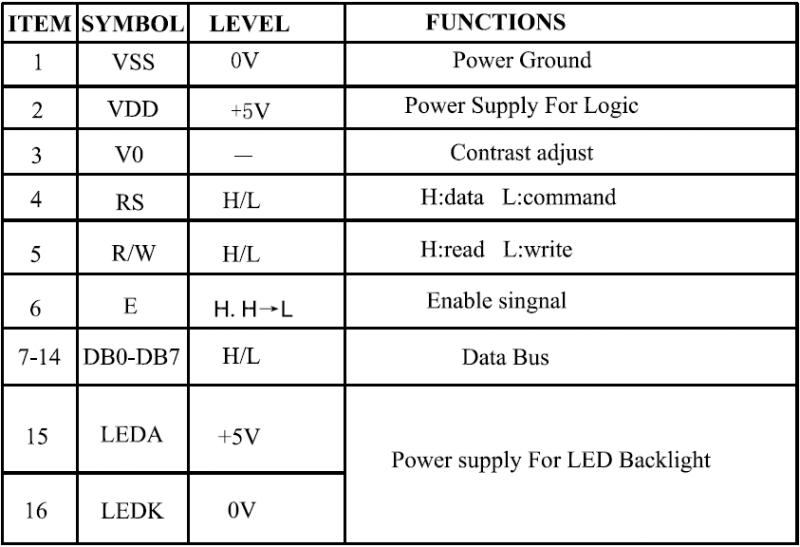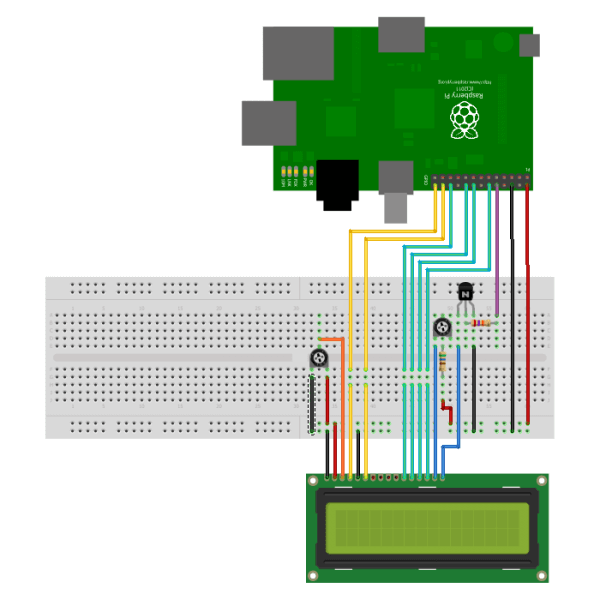采用Python语言控制20×4液晶模块
20×4液晶模块与日立的HD44780液晶控制器是兼容的。以前的文章: 树莓派使用Python控制LCD1602模块曾经做过相关的介绍,本文也是基于这篇文章的内容,进行的相关扩展。
20X4液晶模块
2004A液晶模块的引脚定义

通常情况下普通的液晶模块需要8条数据线来提供0-7位的数据。然而,这个LCD模块可以配置为使用“4位”的模式,允许以4位的两个块来发送数据。这减少了与树莓派连接时所需的GPIO接口数量。
与树莓派的连接
| LCD 模块针 | 功能 | 树莓派针功能 | 树莓派引脚 |
| 01 | GND | GND | P1-06 |
| 02 | +5V | +5V | P1-02 |
| 03 | Contrast | ||
| 04 | RS | GPIO7 | P1-26 |
| 05 | RW | GND | P1-06 |
| 06 | E | GPIO8 | P1-24 |
| 07 | Data 0 | ||
| 08 | Data 1 | ||
| 09 | Data 2 | ||
| 10 | Data 3 | ||
| 11 | Data 4 | GPIO25 | P1-22 |
| 12 | Data 5 | GPIO24 | P1-18 |
| 13 | Data 6 | GPIO23 | P1-16 |
| 14 | Data 7 | GPIO18 | P1-12 |
| 15 | 通过 560 欧电阻接+5V | ||
| 16 | GND | P1-06 |
注意:RW引脚允许设备进入读或写模式。这里把这个引脚接地,为了防止模块发送数据到树莓派,因为树莓派的GPIO引脚不支持5V输入。
引脚3: 控制对比度,可以调整引脚3的电压。这里使用了一个10K欧微调电阻提供了一个0-5V的可变电压给引脚3,就可以实现对比度的调整了。
引脚15:为背光电源。可以打开和关闭背光,这里使用晶体管(BC547, BC548或等效)来实现开关。因此需要一个GPIO引脚实现Python脚本对背光的控制。

Python控制代码
#!/usr/bin/python
# The wiring for the LCD is as follows:
# 1 : GND
# 2 : 5V
# 3 : Contrast (0-5V)*
# 4 : RS (Register Select)
# 5 : R/W (Read Write) - GROUND THIS PIN
# 6 : Enable or Strobe
# 7 : Data Bit 0 - NOT USED
# 8 : Data Bit 1 - NOT USED
# 9 : Data Bit 2 - NOT USED
# 10: Data Bit 3 - NOT USED
# 11: Data Bit 4
# 12: Data Bit 5
# 13: Data Bit 6
# 14: Data Bit 7
# 15: LCD Backlight +5V**
# 16: LCD Backlight GND
#import
import RPi.GPIO as GPIO
import time
# Define GPIO to LCD mapping
LCD_RS = 7
LCD_E = 8
LCD_D4 = 25
LCD_D5 = 24
LCD_D6 = 23
LCD_D7 = 18
LED_ON = 15
# Define some device constants
LCD_WIDTH = 20 # Maximum characters per line
LCD_CHR = True
LCD_CMD = False
LCD_LINE_1 = 0x80 # LCD RAM address for the 1st line
LCD_LINE_2 = 0xC0 # LCD RAM address for the 2nd line
LCD_LINE_3 = 0x94 # LCD RAM address for the 3rd line
LCD_LINE_4 = 0xD4 # LCD RAM address for the 4th line
# Timing constants
E_PULSE = 0.0005
E_DELAY = 0.0005
def main():
# Main program block
GPIO.setmode(GPIO.BCM) # Use BCM GPIO numbers
GPIO.setup(LCD_E, GPIO.OUT) # E
GPIO.setup(LCD_RS, GPIO.OUT) # RS
GPIO.setup(LCD_D4, GPIO.OUT) # DB4
GPIO.setup(LCD_D5, GPIO.OUT) # DB5
GPIO.setup(LCD_D6, GPIO.OUT) # DB6
GPIO.setup(LCD_D7, GPIO.OUT) # DB7
GPIO.setup(LED_ON, GPIO.OUT) # Backlight enable
# Initialise display
lcd_init()
# Toggle backlight on-off-on
lcd_backlight(True)
time.sleep(0.5)
lcd_backlight(False)
time.sleep(0.5)
lcd_backlight(True)
time.sleep(0.5)
while True:
# Send some centred test
lcd_string("--------------------",LCD_LINE_1,2)
lcd_string("Rasbperry Pi",LCD_LINE_2,2)
lcd_string("Model B",LCD_LINE_3,2)
lcd_string("--------------------",LCD_LINE_4,2)
time.sleep(3) # 3 second delay
lcd_string("Basemu",LCD_LINE_1,3)
lcd_string(".com",LCD_LINE_2,3)
lcd_string("",LCD_LINE_3,2)
lcd_string("20x4 LCD Module Test",LCD_LINE_4,2)
time.sleep(3) # 20 second delay
# Blank display
lcd_byte(0x01, LCD_CMD)
time.sleep(3) # 3 second delay
def lcd_init():
# Initialise display
lcd_byte(0x33,LCD_CMD) # 110011 Initialise
lcd_byte(0x32,LCD_CMD) # 110010 Initialise
lcd_byte(0x06,LCD_CMD) # 000110 Cursor move direction
lcd_byte(0x0C,LCD_CMD) # 001100 Display On,Cursor Off, Blink Off
lcd_byte(0x28,LCD_CMD) # 101000 Data length, number of lines, font size
lcd_byte(0x01,LCD_CMD) # 000001 Clear display
time.sleep(E_DELAY)
def lcd_byte(bits, mode):
# Send byte to data pins
# bits = data
# mode = True for character
# False for command
GPIO.output(LCD_RS, mode) # RS
# High bits
GPIO.output(LCD_D4, False)
GPIO.output(LCD_D5, False)
GPIO.output(LCD_D6, False)
GPIO.output(LCD_D7, False)
if bits&0x10==0x10:
GPIO.output(LCD_D4, True)
if bits&0x20==0x20:
GPIO.output(LCD_D5, True)
if bits&0x40==0x40:
GPIO.output(LCD_D6, True)
if bits&0x80==0x80:
GPIO.output(LCD_D7, True)
# Toggle 'Enable' pin
lcd_toggle_enable()
# Low bits
GPIO.output(LCD_D4, False)
GPIO.output(LCD_D5, False)
GPIO.output(LCD_D6, False)
GPIO.output(LCD_D7, False)
if bits&0x01==0x01:
GPIO.output(LCD_D4, True)
if bits&0x02==0x02:
GPIO.output(LCD_D5, True)
if bits&0x04==0x04:
GPIO.output(LCD_D6, True)
if bits&0x08==0x08:
GPIO.output(LCD_D7, True)
# Toggle 'Enable' pin
lcd_toggle_enable()
def lcd_toggle_enable():
# Toggle enable
time.sleep(E_DELAY)
GPIO.output(LCD_E, True)
time.sleep(E_PULSE)
GPIO.output(LCD_E, False)
time.sleep(E_DELAY)
def lcd_string(message,line,style):
# Send string to display
# style=1 Left justified
# style=2 Centred
# style=3 Right justified
if style==1:
message = message.ljust(LCD_WIDTH," ")
elif style==2:
message = message.center(LCD_WIDTH," ")
elif style==3:
message = message.rjust(LCD_WIDTH," ")
lcd_byte(line, LCD_CMD)
for i in range(LCD_WIDTH):
lcd_byte(ord(message[i]),LCD_CHR)
def lcd_backlight(flag):
# Toggle backlight on-off-on
GPIO.output(LED_ON, flag)
if __name__ == '__main__':
try:
main()
except KeyboardInterrupt:
pass
finally:
lcd_byte(0x01, LCD_CMD)
lcd_string("Goodbye!",LCD_LINE_1,2)
GPIO.cleanup()
请注意如果你使用的树莓派版本取本文(P1)不一致,请更新代码中的引脚号。









